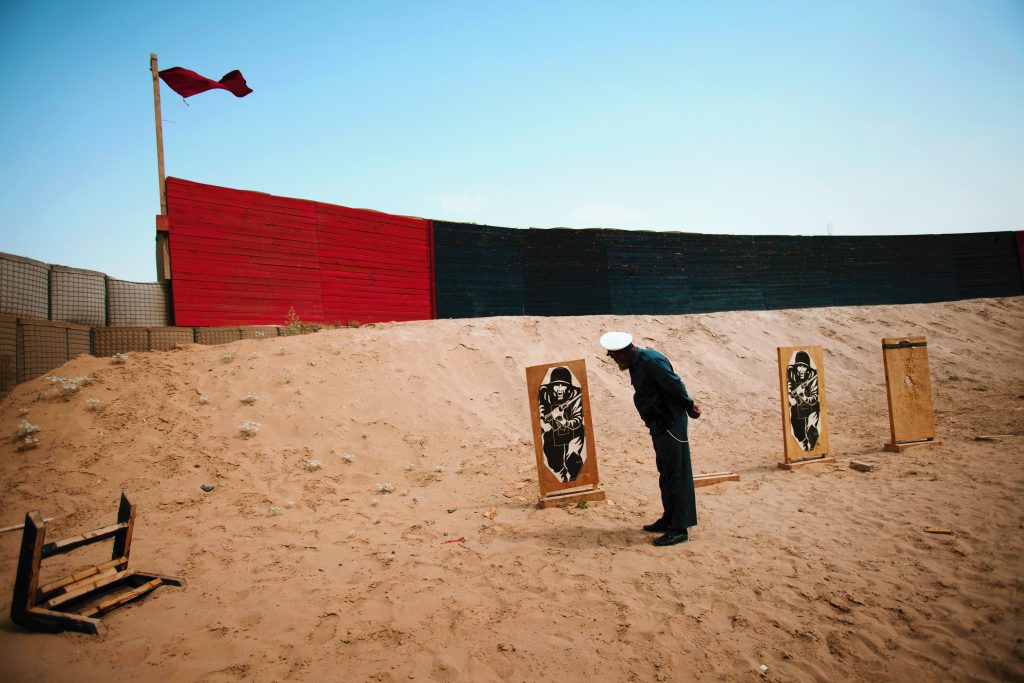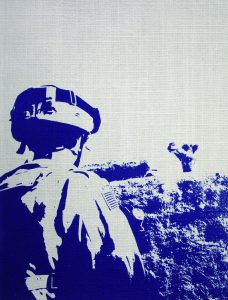(THIS ARTICLE IS MACHINE TRANSLATED by Google from Norwegian)
Christoph Bangert:
Hello Camel
Kehrer imprint, 2016
In the wake of the Nuremberg Trials and World War II genocide cases, Professor of Psychology Stanley Milgram at the Yale University conducted an experiment focusing on the conflict between law-abiding authority and personal conscience. The experiment showed that 60 percent of us are willing to send 450 volts with power through a fellow human being if we are told to do so by an authority – in this case the professor himself. The year before (1959), German-American philosopher Hannah Arendt followed the legal process against Nazi top bureaucrat Adolf Eichmann. Her conclusion was that he was not an evil man, but a very law-abiding man in an evil system. She thus calculated how Milgram's experiment would go, and concluded that the evil is sometimes radical, but most often it is just trivial. In a series of articles in The New Yorker, she defined the term the banality of evil: When the evil is put into routine and cruel actions are accepted without thinking about it, the banality of evil appears. So where does our responsibility as individuals in a society begin and end? Or in war?
 Empathy or defensive wall? In Bangert's previous photo book Was porn, which was nominated for The Aperture Foundation Photo Book Award at Paris Photo in 2014, was the focus of the bestiality of the war. In the little book of pictures so explicit that half of the pages were perforated together so that the viewer himself had to open them, he showed us all the pictures he himself had censored on all his war missions – the pictures that never ended up in the newspaper. He thinks we need to see these pictures to understand the bestiality of the war. When someone has to experience it, we must at least dare to see it in a picture, says Bangert. But what does it really do to us to see images that point to the most horrific human tragedies? Do they increase our capacity for compassion for those who experience these things, or do we set up the shield and build an emotional defensive wall in the face of other people's tragic destiny?
Empathy or defensive wall? In Bangert's previous photo book Was porn, which was nominated for The Aperture Foundation Photo Book Award at Paris Photo in 2014, was the focus of the bestiality of the war. In the little book of pictures so explicit that half of the pages were perforated together so that the viewer himself had to open them, he showed us all the pictures he himself had censored on all his war missions – the pictures that never ended up in the newspaper. He thinks we need to see these pictures to understand the bestiality of the war. When someone has to experience it, we must at least dare to see it in a picture, says Bangert. But what does it really do to us to see images that point to the most horrific human tragedies? Do they increase our capacity for compassion for those who experience these things, or do we set up the shield and build an emotional defensive wall in the face of other people's tragic destiny?
Everyday in war. In his new book Hello Camel Rather, Bangert shows us the absurdity of war; the senseless and the banal, sometimes comical and ridiculous. There are, in a sense, the gaps in the war, all that is beyond the sensational and the actual action. It is the everyday life of the war, situations that have no news value. But these pictures remind us that ordinary people – like us – participate in wars. For anyone who has not experienced war on their own, the idea we have of war is often based on the images we have seen in the press, which are often characterized by action, heroism and death, murder, torture, evil, pain and desperation. But what about the meaningless, depressive, absurd, boring, bland, heavy war?
Hello Camel is purely visual, and the pictures in the book are printed in large formats all the way to the edges, so the pictures speak for themselves: satellite dishes piled up with pallets and earthbags, so that the German soldiers receive TV signals from home. At the edge of the makeshift swimming pool in Camp Nathan in the heart of Kandahar, a woman is sitting in a bikini with her feet in the water reading a book titled Salvation in Death. A solitary camel looks at the soldiers from the other side of the moat. The images ooze loneliness and emptiness, a seclusion and silence that does not testify to community or heroism.
Motivation of war photographers. Why do young men go to war in foreign countries? This is a question that has been much debated in recent times and has complex and multifaceted answers. We talk about radicalization, but also about the sense of alienation in one's own society, and the desire for belonging, community and meaning in life. According to Bangert, the motivations of young photographers traveling to war zones are about much of the same. He says: “In our part of the world, we are afraid to live a normal, meaningless life, and seek adventure and strong opinions. I wanted to go out and experience something extraordinary. As I have built up experiences and learned more about the time I live in, my motivation has changed – now I am more concerned with what stories I tell and how it affects people. ”
The images ooze loneliness and emptiness, a seclusion and silence that does not testify to community or heroism.
 Peace Journalism. If we are to be able to take in the banality of evil, maybe everyday life in war should have more room? But most wars in modern times follow war reporters and war photographers. We send our photographers to the wars far away to report back on the bestial and the heroic, the painful and the tragic, the great battles and the winners and losers. Journalistic research environments have begun to understand the importance of the visual in conflict reporting, and how the construction of narratives in war occurs (here at home with the research project "Narratives on war in journalism and the cultural field" at the Oslo University College and Akershus (HiOA)) . The fact that we now also get pictures of war reported from the people who experience it has given us a number of other perspectives – closer and more subjective.
Peace Journalism. If we are to be able to take in the banality of evil, maybe everyday life in war should have more room? But most wars in modern times follow war reporters and war photographers. We send our photographers to the wars far away to report back on the bestial and the heroic, the painful and the tragic, the great battles and the winners and losers. Journalistic research environments have begun to understand the importance of the visual in conflict reporting, and how the construction of narratives in war occurs (here at home with the research project "Narratives on war in journalism and the cultural field" at the Oslo University College and Akershus (HiOA)) . The fact that we now also get pictures of war reported from the people who experience it has given us a number of other perspectives – closer and more subjective.
In recent years, more and more people have started talking about peace journalism. HiOA offers a master's degree in peace journalism, as do many similar institutions internationally. Peace journalism is a concept originally defined by the Norwegian social scientist and founder of the Institute of Peace Research Johan Galtung, and is now spreading as a global reform movement among editors, reporters, academics and activists. This raises awareness of how to report from war, and how the press largely helps to prevent conflict. The main point is that violence should not be reported as a single event, but as created by structures, cultures and processes in society. Here is a huge potential for the press to contribute to peace prevention work.
From the picture the media gives us, we get the overall impression that we, globally, are in a conflict-filled era characterized by war and misery in a constantly growing spiral. But the statistics tell us the opposite – the number of armed conflicts and the number of people killed in war has been steadily declining since the Cold War – and suggests that the world is actually becoming more peaceful. Peace reporters who are not in search of the sensational, heroic or bestial in the war might place their focus elsewhere? Get us down to a more human level where we can meet both civilians and soldiers as human beings?
Away from the sensation. In order to create images that deal with the overall structures of war, we need reflected photographers who are historians, social scientists and religious scholars. It's no longer possible to set the camera, have pointed elbows and capture the moment to be a good visual reporter. Many photographers have felt threatened in today's media situation, where everyone can submit pictures to the newspapers, and the press largely uses civilians' pictures in war reporting. Bangert believes it is "authorship" that will save the press photographer and the visual storytelling of our time.
I hope we have come to a time where photographers can stop running after the sensation – there are always some who are already there anyway. We need peace photographers who can use the camera to reflect on the time we live in, the conflicts that unfold and the structures that create them.
In the column "Focus on photography» visual artist Nina Toft presents a new photo project or a new photo book every month.


